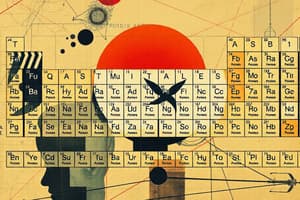Podcast
Questions and Answers
What happens to ionization energy as you move from left to right across a period in the periodic table?
What happens to ionization energy as you move from left to right across a period in the periodic table?
- It stays the same
- It fluctuates
- It decreases
- It increases (correct)
The atomic radius increases as you move from top to bottom within a group.
The atomic radius increases as you move from top to bottom within a group.
True (A)
Define ionization energy.
Define ionization energy.
The energy required to remove an electron from a specific atom.
As the atomic number increases from left to right across a period, the _______ energy increases.
As the atomic number increases from left to right across a period, the _______ energy increases.
Match the following properties with their trends:
Match the following properties with their trends:
What is electronegativity?
What is electronegativity?
Electronegativity increases from top to bottom in a group of the periodic table.
Electronegativity increases from top to bottom in a group of the periodic table.
What happens to electronegativity as you move from left to right across a period?
What happens to electronegativity as you move from left to right across a period?
As the atomic number increases down a group, electronegativity __________.
As the atomic number increases down a group, electronegativity __________.
Match the periodic trends with their correct descriptions:
Match the periodic trends with their correct descriptions:
What is affected when the valence shell of an atom is more than half full?
What is affected when the valence shell of an atom is more than half full?
The atomic radius decreases as you move left to right across a period.
The atomic radius decreases as you move left to right across a period.
Explain why electronegativity decreases down a group.
Explain why electronegativity decreases down a group.
Flashcards
Periodic Trends
Periodic Trends
Patterns in the periodic table showing properties of elements.
Electronegativity
Electronegativity
An atom's ability to attract electrons in a bond.
Ionization Energy
Ionization Energy
Energy needed to remove an electron from an atom.
Electron Affinity
Electron Affinity
Signup and view all the flashcards
Atomic Radius
Atomic Radius
Signup and view all the flashcards
Melting Point
Melting Point
Signup and view all the flashcards
Metallic Character
Metallic Character
Signup and view all the flashcards
Trend Across a Period
Trend Across a Period
Signup and view all the flashcards
Trend Across Periods
Trend Across Periods
Signup and view all the flashcards
Trend Within Groups
Trend Within Groups
Signup and view all the flashcards
Trend in Atomic Radius
Trend in Atomic Radius
Signup and view all the flashcards
Study Notes
Periodic Trends
- Trends in the periodic table illustrate various element properties, including size and electronic properties.
- Key periodic trends include electronegativity, ionization energy, electron affinity, atomic radius, melting point and metallic character.
Electronegativity
- Electronegativity is an atom's ability to attract electrons in a chemical bond.
- Electronegativity increases from left to right across a period.
- Electronegativity decreases from top to bottom down a group. This is due to increasing distance between the valence electrons and the nucleus as the atomic radius increases.
Ionization Energy
- Ionization energy is the energy needed to remove an electron from an atom.
- Ionization energy increases from left to right across a period. It’s due to increased attraction between the protons in the nucleus and electrons in the valence shell.
- Ionization energy decreases from top to bottom within a group as the size of the atom increases. This distance between the nucleus and valence electrons increases.
Atomic Radius
- Atomic radius is the distance between the center of the nucleus and the outermost electron shell.
- Atomic radius decreases from left to right across a period due to increased nuclear charge and decreased shielding of electrons.
- Atomic radius increases from top to bottom down a group due to the addition of electron shells.
Studying That Suits You
Use AI to generate personalized quizzes and flashcards to suit your learning preferences.
Related Documents
Description
This quiz focuses on the trends in ionization energy and atomic radius across periods and down groups in the periodic table. It also includes definitions and matching exercises to enhance understanding of these concepts.




